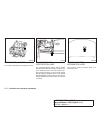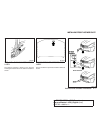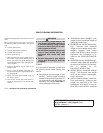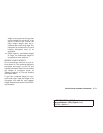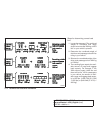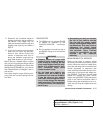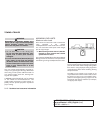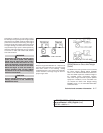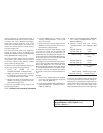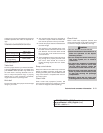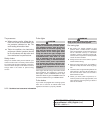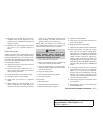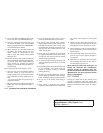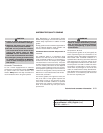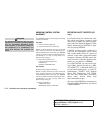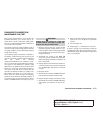
Towing capacities are calculated assuming a
base vehicle with driver and any options required
to achieve the rating. Additional passengers,
cargo and/or optional equipment, such as the
trailer hitch, will add weight to the vehicle and
reduce your vehicle’s maximum towing capacity
and trailer tongue load.
The vehicle and trailer need to be weighed to
confirm the vehicle is within the GVWR, Front
GAWR, Rear GAWR, Gross Combined Weight
Rating (GCWR) and Towing capacity.
All vehicle and trailer weights can be measured
using platform type scales commonly found at
truck stops, highway weigh stations, building
supply centers or salvage yards.
To determine the available payload capacity for
tongue load, use the following procedure.
1. Locate the GVWR on the
F.M.V.S.S./C.M.V.S.S. certification label.
2. Weigh your vehicle on the scale with all of
the passengers and cargo that are normally
in the vehicle when towing a trailer.
3. Subtract the actual vehicle weight from the
GVWR. The remaining amount is the avail-
able maximum tongue load.
To determine the available towing capacity, use
the following procedure.
1. Find the GCWR for your vehicle on the
ЉTowing Load/SpecificationЉ chart found
later in this section.
2. Subtract the actual vehicle weight from the
GCWR. The remaining amount is the avail-
able maximum towing capacity.
To determine the Gross Trailer Weight, weigh
your trailer on a scale with all equipment and
cargo, that are normally in the trailer when it is
towed. Make sure the Gross Trailer Weight is not
more than the GrossTrailer Weight Rating shown
on the trailer and is not more than the calculated
available maximum towing capacity.
Also weigh the front and rear axles on the scale to
make sure the Front Gross Axle Weight and Rear
Gross Axle Weight are not more than Front
Gross Axle Weight and Rear Gross Axle Weight
on the F.M.V.S.S./C.M.V.S.S. certification label.
The cargo in the trailer and vehicle may need to
be moved or removed to meet the specified rat-
ings.
Example:
● Gross Vehicle Weight (GVW) as weighed
on a scale- including passengers, cargoand
hitch - 5,470 lb. (2481 kg).
● Gross Vehicle Weight Rating (GVWR) from
F.M.V.S.S./C.M.V.S.S. certification label -
5,820 lb. (2640 kg).
● Gross Combined Weight Rating (GCWR)
from “Towing Load/SpecificationЉ chart -
8,500 lb. (3856 kg).
● Maximum Towing Load from “Towing
Load/SpecificationЉ chart - 3,500 lb. (1587
kg).
5,820 lb. (2640 kg) GVWR
– 5,470 lb. (2481 kg) GVW
= 350 lb. (158 kg) Available for tongue
weight
8,500 lb. (3856 kg) GCWR
– 5,470 lb. (2481 kg) GVW
= 3,030 lb. (1375 kg) Capacity available for
towing
350 lb. (158 kg) Available tongue weight
/ 3,030 lb. (1375 kg) Available capacity
= 11 % tongue weight
In this case, the available towing capacity is 470
lb. (213 kg) less than the maximum towing ca-
pacity due to the passenger and cargo load in the
vehicle. Remember to keep trailer tongue weight
between 10 – 15 % of the trailer weight. If the
tongue load becomesexcessive, rearrange cargo
9-18 Technical and consumer information
੬ REVIEW COPY—
2007 Quest (van)
Owners Manual—USA_English (nna)
02/27/06—debbie
੭



